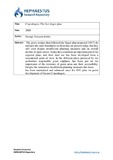| dc.contributor.author | Georgi, Neratzia Julia | |
| dc.date.accessioned | 2016-04-22T06:11:00Z | |
| dc.date.available | 2016-04-22T06:11:00Z | |
| dc.date.issued | 2008 | |
| dc.identifier.isbn | 978-88-7970-345-1 | |
| dc.identifier.uri | http://hdl.handle.net/11728/7563 | |
| dc.description.abstract | The green wedges that followed the finger plan proposed (1947) do not have the same boundaries as those that are present today, but they still exist despite insufficient planning measures and an overall decline of open spaces. Today they constitute an important part of the regional plans and their land use has been developed from a recreational point of view. In the different plans produced by the authorities responsible great emphasis has been put on the importance of the existence of green areas and their accessibility. Despite the sometimes insufficient planning measures this focus
has been maintained and enhanced since the 1947 plan for green development of Greater Copenhagen. | en_UK |
| dc.language.iso | en | en_UK |
| dc.publisher | Edifir - Edizioni Firenze | en_UK |
| dc.relation.ispartofseries | Linking Urban Developments to Green Areas An overview of good practices in Europe;p.p 82-83 | |
| dc.rights | © 2008 by Edifir - Edizioni Firenze | en_UK |
| dc.rights.uri | http://creativecommons.org/licenses/by-nc-nd/4.0/ | en_UK |
| dc.subject | Five Finger Plan | en_UK |
| dc.subject | Copenhagen | en_UK |
| dc.subject | land | en_UK |
| dc.title | Copenhagen- The five finger plan | en_UK |
| dc.type | Book chapter | en_UK |


